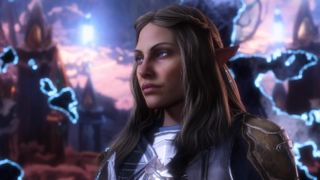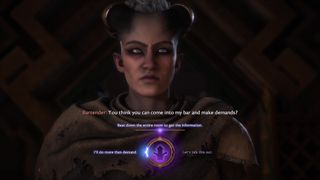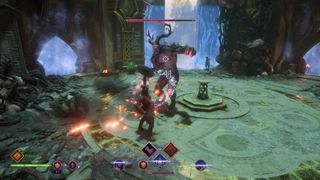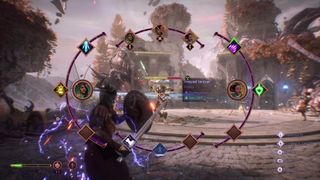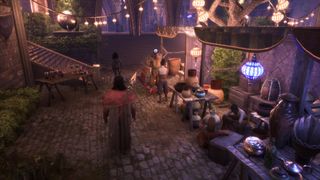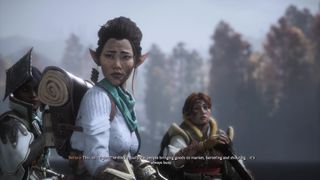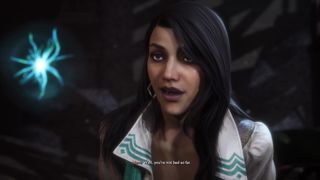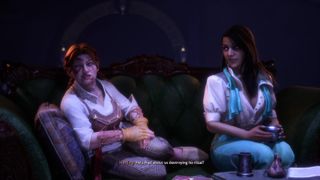What I learned talking to BioWare about Dragon Age: The Veilguard
"I don't think we're ever going to make everyone happy."

Image credit: EA / BioWare
I was fortunate enough to play
Dragon Age: The Veilguard for several hours recently, exploring multiple missions and trying multiple characters at multiple levels and using differing builds, and it was good, I really liked it. You can
read my much lengthier preview impressions of Dragon Age: The Veilguard elsewhere on the site. But here I want to cobble together some of the things I learned while interviewing co-game director John Epler, and taking part in a group Q&A with other lead developers working on the game.
Veilguard has really only been in full production for about four years
Technically it's been 10 years since the previous Dragon Age game, Inquisition, but that doesn't mean Veilguard has been in full development the entirety of the time. The team has been iterating on ideas ever since Inquisition add-on Trespasser came out, "But in terms of the actual game as you're seeing it now, as it's shaped today, I'd say four years," John Epler tells me. "That's when everything just started to come together and you're like, oh yeah, yep, this is what we want. This is what we need for this Dragon Age game."
There have been rumours the game has undergone some fairly major revisions during its protracted development time. "Absolutely," says Epler, when I ask him. "The version that we were working on back then and the version working on now: there's definitely similarities - you'll see names that are the same in terms of the major actors, obviously Solas is still part of it - but the structure of the game has definitely changed as we refined as we built, and again, as we really focused on making it a single-player story based RPG."
It's single-player now, but BioWare did try some multiplayer ideas
BioWare hasn't been shy about experimenting with multiplayer in the past.
Mass Effect had a fairly established co-operative multiplayer mode, and Anthem was built around it. Even
Dragon Age: Inquisition had a dungeon-delving, four-player co-op multiplayer mode. It won't come as a shock, then, to know BioWare explored having it in its newest Dragon Age game too. "We tried a bunch of different things - multiplayer is one of them," Epler says. "We tried a few opportunities, how it would work and what didn't. But what it comes down to is we are a studio that's made around, that's been constructed and honestly staffed around, building these single-player story-based experiences, so once we started focusing on that, that's when things really came together for us."
There are three acts in the game, and it feels large
My day's play was spread across the first act of the game, playing through character creation right up to level 30 and the Siege of Weisshaupt, which serves as the dramatic climax for the first act of The Veilguard. It is spectacular in terms of the events unfolding and the size of the enemy it throws at you there - those of you who played
Dragon Age: Origins will know the enemy well.
Given the level range I experienced - one to 30 - it suggests Act One will occupy us for a considerable amount of time. But it's not necessarily a like-for-like calculation, as far as the other acts and their relative lengths are concerned. "We've basically broken it down into essentially a three-act structure," Epler explains. "Each act is different though. Not every act is the exact same as the other one, and a lot of the content that's not [on] the critical path you can do at any time. [...] We describe it as context-shifts: at the end of each act, the context shifts, the world changes, and how Rook approaches their fight against the gods is going to change accordingly."
"One of the things I'd add as well," Veilguard co-director Corinne Busche says, "is the conclusion of this game needs to matter. It needs to be the natural conclusion of your efforts and building up the Veilguard and taking on these gods, and Weisshaupt really serves as your first true demonstration of what you're up against. So while it is a large first act, and it is a very climactic mission to cap it off, from my perspective that is where you really get that sense of the overwhelming power, the stakes of what's here."
In other words, Act One may be larger and longer than the others.

Image credit: BioWare
BioWare learnt its lesson from the infamous Inquisition Hinterlands slog
Dragon Age: Inquisition made pretensions at being an open-world game. It wasn't, natively, but it did have several zones that were equivalent to open-world areas, where you had settlements as well as areas of adventure and danger around them. The Hinterlands was one of them. But it's a zone now remembered for being a slog - for being a zone filled with collectibles and other arbitrary forms of content designed, seemingly, just to keep you busy and fill the map up. The difference in The Veilguard is it won't be an open-world game. It is, as I heard several times during my demo-day, a mission-based game, which is to say the missions are like levels, with shaped beginnings, middles and ends. There's the potential to revisit some of them, like the Crossroads, where there are slightly more open-ended things to do, but overall, it's a much tighter and more focused experience.
"We wanted it to all feel very deliberate and handcrafted, so those missions, we learnt our lessons from the Hinterlands," Epler says. "They're not meant to be fetch quests; they have story, they have narrative, they tie into the story of the space, tie into the larger arc of the characters or of the plot, or tie into how the various factions interact with these spaces they inhabit."
"I'll tell you what," Busche adds, "it's hard to buck trends sometimes, but we really felt we could tell the best stories, we could create the most curated moment-to-moment experience by really going back to a mission-based structure."
Less control over companions is intended to make them feel more like autonomous beings
In The Veilguard, a layer of companion micro-management has been removed. You don't play as them. You can order some of their special attacks and you can equip a few equipment slots, and customise bond abilities relative to their bond level with you, but otherwise, they are autonomous. They feel like people around you rather than a party you control, and for what it's worth, I thought it worked well - there was actually more control over them than I'd expected. But it's a design decision that's come under some scrutiny as the series seems to move away from being party-based.
"Our North Star," Busche says, "was we wanted you to embody Rook, to step into Rook's shoes, to experience this world on the ground as this character, and what that meant is giving you more autonomy, more control of the character, putting you in control of every single swing, really making it feel like you're a part of this world. And what's more, we talked a lot about - I know a lot of the questions that came up today were about the companions, the depth, the authenticity - we really felt like there was a big opportunity here to make the companions feel more realised, more like they're characters that fight alongside you, that have their own styles, motivations, interactions, if you're not actually embodying them.
"But of course, throughout all of that, we do know in the combat system, that sense of teamwork - of pause and play tactical depth - has been the through-line through every single edition of Dragon Age, so we wanted to walk the fine line of making that teamwork and sense of strategy show up but also make you feel like you're in this world."
"But also," Epler adds, "part of making the companions feel like their own people, like their own characters, is giving them that autonomy as well on the battlefield. You are the leader of this group but they have their own personalities, their own stories, and we wanted to make sure that you felt that through the gameplay as well."

Image credit: BioWare
You can romance any companion character but it's not, apparently, player-sexual
BioWare has received flak over the decision to make The Veilguard more open romantically, in the sense you can romance any companion character in the game regardless of who your Rook is - what their gender is, what their race is. In previous BioWare games, this hasn't been the case. Inquisition famously had Dorian, a gay man, only romance other gay men, and as every-day as this sounds, it was remarkable for the studio at the time. Inquisition also had Solas romance only female elves, so characters there had defined preferences, whereas now, they don't seem to, and it's caused some aggravation. But it sounds like there may be
some preference and differentiation after all.
"One of the things we wanted to allow is player choice as much as possible, so being able to develop a romance with any character no matter who your Rook is," Epler says. "But those romances may play out a little bit differently based on every activity, based on how you built your Rook, how you customise them."
Co-director Corinne Busche then adds: "Handling romances and romantic options, it's quite the challenge, and to be honest with you all, I'm not sure there's a right answer on how to approach it. What we felt was best for this game was to make sure that you could romance the companions, but I want to be clear that it's not player sexual," she says. " These are fully fleshed out characters that have their own romantic histories, preferences, backgrounds, and that doesn't change based on who you, the player character, are. They don't adapt their personalities to conform to the player and that's fundamentally the difference. There's merits to it and challenges. We're also mindful to have characters in the world of all orientations, so that we do get that really thoughtful representation again where people can see themselves."
You can't really be evil in The Veilguard
Given my outrageous antics in my
Let's Get Evil in Baldur's Gate 3 series, the ability to negatively affect a world is of prime importance to me. Grin. It's actually something that began with Dragon Age: Origins many years ago, as Morrigan and a desire for blood magic led me off my normal goodie-two-shoes path and somewhere darker altogether. But BioWare games have changed since then, and you haven't been able to be evil in them for some years now. I'm not actually sure which the last game was that you could be evil in -
Dragon Age 2, was it, or Star Wars: The Old Republic?
The same is true of The Veilguard, to my disappointment, and it's something I saw firsthand in the dialogue options on the day: there was really only the option to be abrupt rather than outright nasty. "Rook is a character who, because of where the world is, because of the stakes, they need to stop the elven gods," Epler explains. "Why you do that - your motivations for doing that and how you approach it - you do have a lot of choice in how you approach those missions. There's some big choices in the game fairly early on where you can do some things that are pretty morally not spectacular, but it's not a game where you can go off and murder a bunch of orphans," he says. "But we want to give you that feeling of 'I know I can build this character that I can role-play in a way that I'm passionate about and excited to do'."
In a broader sense, I also didn't see much differentiation in dialogue outcomes. There was a sense that my responses were variations on pre-destined outcomes rather than differing courses altogether. That doesn't mean there aren't some major choice moments, though. "There is at least, and I won't get into spoilers, but there are definitely a couple of fairly significant choices that reshape the world in pretty [big] ways," Epler says.
I didn't see any dialogue-affecting skills such as BioWare games have had in the past, either, though there are additional dialogue options activated according to your faction, race, and class. "We wanted to focus on base reactivity," Epler says. "One of the things with dialogue skills, and this was true in Mass Effect, is the moment you have one, that's where you're putting your first 20 skill points, because, 'well if this is going to unlock special things for me...'" I'm not ashamed to say I know exactly what he's talking about.

Image credit: BioWare
There's no Keep for importing saves but something broadly equivalent
There's no external Keep feature for importing past Dragon Age saved data into the game this time, but there is something else built into the game itself. During character creation, you'll have the ability to import your Inquisitor from Inquisition, and all of the associated major decisions they made during the game. If you don't have an Inquisitor, you can make one, in The Veilguard, customising their look as well as choosing what you would have done in the game.
The reason why it's done this way is two-fold. Firstly, it helps contain the amount of choice being brought in from previous games, because as Epler points out, a lot of choices made in previous Dragon Age games pertain to places that just aren't relevant here. "For us, the core philosophy was we want you to make choices that matter, choices that we can actually reflect," Epler says. "Part of going to northern Thedas is a lot of stuff that matters tremendously if you're in Ferelden and Orlais doesn't matter as much in Tevinter."
The other reason it's been done this way is to serve as an onboarding tool. As Busche says, "It's been a long time since Inquisition, even if you're a die-hard fan. Unless you're watching a YouTube replay of the whole game, you might have little cobwebs on the choices you made or the implications of them. So not only did we want to allow this to be an in-game feature that would allow you to replicate those choices that John mentioned are contextually appropriate to the game, but we also view it as a dual-purpose onboarding tool. If I'm a player that I just don't remember or I haven't played the past games, you're going to go in and those choices, those beautiful tarot cards that Matt [Rhodes, art director] and his team put together, with all the context around what these choices meant, why they mattered. So I really view it as a beautiful onboarding tool as well."
It may be divisive, but BioWare believes The Veilguard will, ultimately, win people around
Ever since being unveiled a few months ago, The Veilguard has proved divisive. First there was the name change from Dreadwolf to The Veilguard, then the reveal of the art style, then the comparisons to Baldur's Gate 3. Whatever BioWare seems to do, it seems it can't please everybody, but Epler isn't disheartened by it.
The art style, for one, he believes is timeless. "It's still going to look striking in 10 years, 15 years," he says. And the more that people see the game in motion, the more convinced he says they are by it. For what it's worth, I agree. The Veilguard was gorgeous when I played it and one of the best looking BioWare games I've seen. "I mean obviously people have their thoughts," he adds, "and in the case of a game like The Veilguard, and you spoke to it earlier, this is a game where the last one came out 10 years [ago], so people had that long to think about what [a new one] could be. Whatever version of the game you had in your head, it doesn't matter what it was, it was never going to be the version of the game you saw."
He continues: "Any time you make a change to anything that's been around for a while, there's going to be some element of divisiveness, and what really it comes down to is believing in the direction you're going and then showing people more of it, showing people why it makes sense in context," which is why BioWare is trying to do exactly that with official blog posts and preview events like these. "There's always going to be some people who aren't happy with one element or another, and that's true of anything that you create."
BioWare, though, attracts a fierce kind of scrutiny, perhaps more than any other developer I've known. It speaks to the amount of people BioWare's games have reached over the decades, and the effect those games have had on them, as they have on me. But a byproduct of being around for so long is, inevitably, change. The BioWare that made Baldur's Gate 2 or even Dragon Age: Origins is not the same BioWare that's making The Veilguard now. Key personnel have changed, the company has fundamentally changed, and so have the games being made today.

Image credit: BioWare
We know this and yet the phenomenal success of Baldur's Gate 3 has rekindled a spark of mutiny about why modern day BioWare isn't like olden day BioWare. Larian made a great success of a traditional CRPG after all. "Honestly I love that Baldur's Gate 3 was so successful," Epler says, "because as an RPG creator, as an RPG, it expands the market, it expands the people who are going to want to play your game and who are passionate about it.
"In the case of Baldur's Gate 3, they have a very specific focus and we have a very specific focus, and we talk to people at Larian all the time. There's friendships. We love Baldur's Gate; they talk about Dragon Age as well, and it's always strange to hear the idea there's this conflict because we just want the other people to do well. Because if Baldur's Gate 3 does well, suddenly you've got millions of people who are ready for another fantasy RPG experience - and we have The Veilguard."
Then he says something I was hoping to hear, because in the past, it seemed BioWare was trying to please other people rather than focus on what
it felt was best. But with The Veilguard, a single-player, mission-based RPG, it seems much more confident to walk its own path, and I think you can feel this in the game itself.
"I don't think you'll ever make [everyone happy]," Epler says, "and I think honestly if you do try to make everyone happy on any creative product, you ultimately end up making no-one happy, because you're compromising one thing for another thing. You end up in a mushy middle where nobody's happy because you're not you're not doing X well enough for the people who like X, you're not doing Y well enough for the people like Y, and more importantly, you yourself as a creator are not making the thing that you believe in, that you think it should be. I always find design by committee in a lot of ways ends up being the death of creative endeavours, when you're trying to make everyone happy.
"I don't think we're ever going to make everyone happy," he adds. "There's always going to be someone who's unhappy. But ultimately it's about making the best version of the game that you believe, as a creator, is the game it needs to be, and then putting it out there. Some people will love it and some people won't, but at least you'll have those people who love it because you did care enough to go in that direction that you felt was right."










































